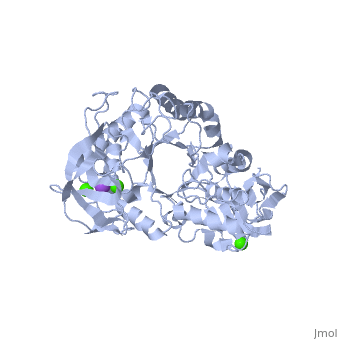Raghad zoubi
From Proteopedia
(Difference between revisions)
| Line 2: | Line 2: | ||
<StructureSection load='1hvx' size='340' side='right' caption='α-Ameylase' scene=''> | <StructureSection load='1hvx' size='340' side='right' caption='α-Ameylase' scene=''> | ||
'''α-Amylase''' is a protein enzyme EC 3.2.1.1 that hydrolyses alpha bonds of large, alpha-linked polysaccharides, such as starch and glycogen, yielding glucose and maltose. It is the major form of amylase found in humans and other mammals.It is also present in seeds containing starch as a food reserve, and is secreted by many fungi. <ref>http://en.wikipedia.org/wiki/Alpha-amylase</ref> | '''α-Amylase''' is a protein enzyme EC 3.2.1.1 that hydrolyses alpha bonds of large, alpha-linked polysaccharides, such as starch and glycogen, yielding glucose and maltose. It is the major form of amylase found in humans and other mammals.It is also present in seeds containing starch as a food reserve, and is secreted by many fungi. <ref>http://en.wikipedia.org/wiki/Alpha-amylase</ref> | ||
| + | |||
== Introduction == | == Introduction == | ||
The <scene name='60/609816/Alpha-amylase/1'>Alpha-amylase</scene> (EC 3.2.1.1 ) (CAS# 9014-71-5) (alternative names: 1,4-α-D-glucan glucanohydrolase; glycogenase) are calcium metalloenzymes, completely unable to function in the absence of calcium. By acting at random locations along the starch chain, α-amylase breaks down long-chain carbohydrates, ultimately yielding maltotriose and maltose from amylose, or maltose, glucose and "limit dextrin" from amylopectin. Because it can act anywhere on the substrate, α-amylase tends to be faster-acting than β-amylase. In animals, it is a major digestive enzyme, and its optimum pH is 6.7–7.0 | The <scene name='60/609816/Alpha-amylase/1'>Alpha-amylase</scene> (EC 3.2.1.1 ) (CAS# 9014-71-5) (alternative names: 1,4-α-D-glucan glucanohydrolase; glycogenase) are calcium metalloenzymes, completely unable to function in the absence of calcium. By acting at random locations along the starch chain, α-amylase breaks down long-chain carbohydrates, ultimately yielding maltotriose and maltose from amylose, or maltose, glucose and "limit dextrin" from amylopectin. Because it can act anywhere on the substrate, α-amylase tends to be faster-acting than β-amylase. In animals, it is a major digestive enzyme, and its optimum pH is 6.7–7.0 | ||
| Line 8: | Line 9: | ||
The α-amylases form is also found in plants, fungi (ascomycetes and basidiomycetes) and bacteria (Bacillus) <ref>http://en.wikipedia.org/wiki/Amylase</ref> | The α-amylases form is also found in plants, fungi (ascomycetes and basidiomycetes) and bacteria (Bacillus) <ref>http://en.wikipedia.org/wiki/Amylase</ref> | ||
| + | |||
==Industrial use== | ==Industrial use== | ||
α-Amylase is used in ethanol production to break starches in grains into fermentable sugars. | α-Amylase is used in ethanol production to break starches in grains into fermentable sugars. | ||
| Line 16: | Line 18: | ||
== Structural highlights == | == Structural highlights == | ||
| - | Shown as 1hvx is the structure of the thermostable α-amylase of Bacillus stearothermophilus (BSTA)[3]. BSTA is comprised of a single polypeptide chain. This chain is folded into three domains: A, B and C. These domains are generally found on all α-amylase enzymes. The <scene name='60/609816/A_domain/1'>A domain</scene> constitutes the core structure, with a (β/α)8-barrel.The B domain consists of a sheet of four anti-parallel β-strands with a pair of anti-parallel β-strands. Long loops are observed between the β-strands. Located within the B domain is the binding site for Ca2+-Na+-Ca2+. Domain C consisting of eight β-strands is assembled into a globular unit forming a Greek key motif. It also holds the third Ca2+ binding site in association with domain A. Positioned on the C-terminal side of the β-strands of the (β/α)8-barrel in domain A is the active site. The catalytic residues involved for the BSTA active site are Asp234, Glu264, and Asp331 | + | Shown as 1hvx is the structure of the thermostable α-amylase of Bacillus stearothermophilus (BSTA)[3]. BSTA is comprised of a single polypeptide chain. This chain is folded into three domains: A, B and C. These domains are generally found on all α-amylase enzymes. The <scene name='60/609816/A_domain/1'>A domain</scene> constitutes the core structure, with a (β/α)8-barrel.The <scene name='60/609816/B_domain/1'>B domain</scene> consists of a sheet of four anti-parallel β-strands with a pair of anti-parallel β-strands. Long loops are observed between the β-strands. Located within the B domain is the binding site for Ca2+-Na+-Ca2+. Domain C consisting of eight β-strands is assembled into a globular unit forming a Greek key motif. It also holds the third Ca2+ binding site in association with domain A. Positioned on the C-terminal side of the β-strands of the (β/α)8-barrel in domain A is the active site. The catalytic residues involved for the BSTA active site are Asp234, Glu264, and Asp331 |
| - | + | ||
| - | + | ||
</StructureSection> | </StructureSection> | ||
Revision as of 18:32, 22 November 2014
Example page for α-Ameylase
| |||||||||||
References
- ↑ http://en.wikipedia.org/wiki/Alpha-amylase
- ↑ http://en.wikipedia.org/wiki/Amylase
- ↑ "The use of enzymes in detergents". Faculty of Engineering, Science and the Built Environment, London South Bank University. 20 December 2004. Archived from the original on 20 October 2009. Retrieved 21 November 2009.

